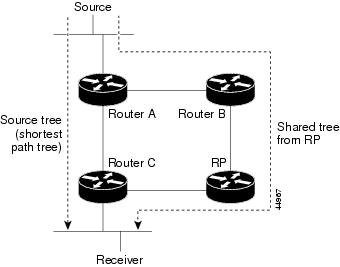PIM sparse mode (PIM-SM) uses a pull model to deliver multicast traffic. Only network segments with active receivers that
have explicitly requested the data will receive the traffic.
Unlike dense mode interfaces, sparse mode interfaces are added to the multicast routing table only when periodic Join messages
are received from downstream routers, or when a directly connected member is on the interface. When forwarding from a LAN,
sparse mode operation occurs if an RP is known for the group. If so, the packets are encapsulated and sent toward the RP.
When no RP is known, the packet is flooded in a dense mode fashion. If the multicast traffic from a specific source is sufficient,
the first hop router of the receiver may send Join messages toward the source to build a source-based distribution tree.
PIM-SM distributes information about active sources by forwarding data packets on the shared tree. Because PIM-SM uses shared
trees (at least, initially), it requires the use of a rendezvous point (RP). The RP must be administratively configured in
the network. See the Rendezvous Points section for more information.
In sparse mode, a router assumes that other routers do not want to forward multicast packets for a group, unless there is
an explicit request for the traffic. When hosts join a multicast group, the directly connected routers send PIM Join messages
toward the RP. The RP keeps track of multicast groups. Hosts that send multicast packets are registered with the RP by the
first hop router of that host. The RP then sends Join messages toward the source. At this point, packets are forwarded on
a shared distribution tree. If the multicast traffic from a specific source is sufficient, the first hop router of the host
may send Join messages toward the source to build a source-based distribution tree.
Sources register with the RP and then data is forwarded down the shared tree to the receivers. The edge routers learn about
a particular source when they receive data packets on the shared tree from that source through the RP. The edge router then
sends PIM (S,G) Join messages toward that source. Each router along the reverse path compares the unicast routing metric of
the RP address to the metric of the source address. If the metric for the source address is better, it will forward a PIM
(S,G) Join message toward the source. If the metric for the RP is the same or better, then the PIM (S,G) Join message will
be sent in the same direction as the RP. In this case, the shared tree and the source tree would be considered congruent.
If the shared tree is not an optimal path between the source and the receiver, the routers dynamically create a source tree
and stop traffic from flowing down the shared tree. This behavior is the default behavior in software. Network administrators
can force traffic to stay on the shared tree by using the ip pim spt-threshold infinity command.
PIM-SM scales well to a network of any size, including those with WAN links. The explicit join mechanism prevents unwanted
traffic from flooding the WAN links.








 Feedback
Feedback